1942 was a pivotal year in American history, as the attack on Pearl Harbor officially brought the United States into World War II. This major global conflict had far-reaching effects—not just on military strategy and civilian life, but even on the production of everyday items like coins. The 1942 Wheat Penny is a perfect example of this, with its design, composition, and minting choices reflecting the pressures of the wartime economy.
Let’s take a look at the current market value of the 1942 Wheat Penny across its different variations and grades:
1942 Wheat Penny Value Chart (in Mint State and Proof)
| Coin Type | MS 65 | MS 66 | MS 67 | MS 67+ | MS 68 | PR 67 CAM |
|---|---|---|---|---|---|---|
| 1942-S (San Francisco) | $26 | $38 | $185 | $575 | $9,500 | – |
| 1942-D (Denver) | $22 | $26 | $175 | $525 | $8,000 | – |
| 1942 (Philadelphia, no mark) | $22 | $38 | $200 | $900 | $3,960 | – |
| 1942 (Philadelphia Proof) | – | – | – | – | – | $18,000 |
These values are based on auction records and price guides for coins in pristine, uncirculated condition. The highest values are reserved for red-colored coins with perfect or near-perfect strikes, particularly those graded MS68 or proof coins with cameo contrast.
If you’re lucky enough to have one of these 1942 Wheat Pennies in your collection, especially in high grade, it could be worth quite a bit—particularly in today’s thriving collector market.
History of the 1942 Wheat Penny
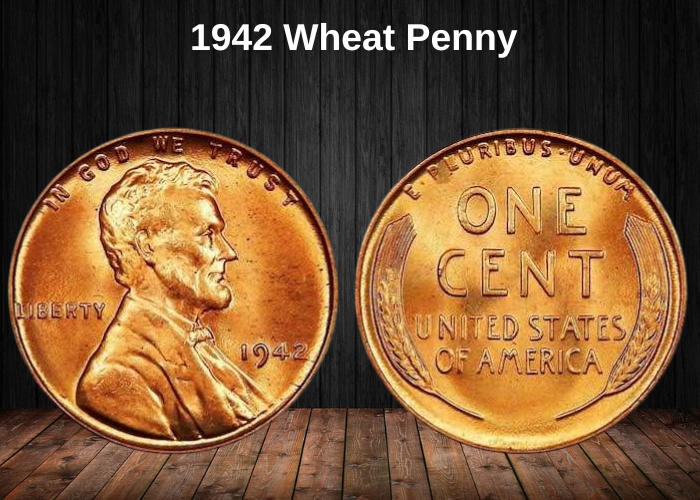
By 1942, World War II was in full effect, and the U.S. Mint, like many industries, was feeling the pressure. Essential metals like nickel and copper were urgently needed for military equipment, forcing the Mint to experiment with alternative coinage materials.
Silver coins—such as Dimes, Quarters, Half Dollars, and Dollars—remained unchanged, maintaining their traditional 90% silver and 10% copper composition until the Coinage Act of 1965, which responded to a silver shortage. However, lower denomination coins were more immediately impacted by wartime needs.
- Nickels, which previously consisted of 75% copper and 25% nickel, were redesigned in 1942. Wartime Nickels contained 35% silver, 56% copper, and 9% manganese—a change intended to conserve both copper and nickel for military production.
- Pennies, normally 95% copper and 5% tin/zinc, were also under scrutiny. The most dramatic change came in 1943, when the Mint introduced Steel Pennies (also known as Wartime Cents or Steelies). These coins had a steel core coated in zinc to help prevent rust—but the protection didn’t hold up well, and corrosion became a common issue.
Despite these experimental changes, the Mint continued to produce regular bronze Lincoln cents throughout 1942 for everyday use. A limited number of proof-like coins were also made for collectors.
Interestingly, as rumors of material changes spread, people began hoarding 1942 pennies, unsure whether the new wartime issues would last for months or even years. That speculation has given many 1942 cents a premium in today’s collector market. After all, they represent the final chapter of the classic copper penny era before the wartime overhaul.
The Legacy of Steel War Pennies
Since the Steel Penny experiment didn’t turn out as expected, these coins were only officially minted in 1943, with a few rare stragglers appearing in 1944. However, the experimentation phase actually began in 1942.
During that year, the U.S. Mint tested several pattern coins using a variety of alternative materials—including glass, plastic, aluminum, white metal, and the zinc-coated steel that would eventually become the standard for 1943.
Interestingly, the Mint also experimented with a design using the obverse (heads) of the Colombian Two Centavo coin. At least two of these trial pieces were struck in glass and featured the Two Centavo obverse with an olive wreath reverse. One of those glass samples is known to be broken in half, while another, preserved in remarkable condition and graded SP 64, sold for $70,500 on January 4, 2017.
Other Colombian-based experimental strikes were created using unusual materials like Bakelite, lead, hard rubber, manganese, red fiber, amber, zinc, bronze, and brass. These prototypes highlight just how far the Mint was willing to go in its search for viable alternatives during wartime resource shortages.
Features of the 1942 Wheat Penny
Let’s start by breaking down some basic coin terminology. Understanding the anatomy of a coin can make collecting and evaluating them a lot easier.
- The front or “heads” side is known as the obverse.
- The back or “tails” side is the reverse.
- Any images or portraits on the coin are called devices.
- Inscriptions such as “IN GOD WE TRUST” or “E PLURIBUS UNUM” are referred to as legends or mottos.
- Numbers, such as the year the coin was minted, are simply called the date or numerals.
- The outermost raised edge of the coin is called the rim or collar.
- The flat background surface that surrounds the device and inscriptions is known as the field.
- The edge, or the thin side of the coin, can either be plain, reeded (with ridges), or lettered depending on the design.
Now that you’ve got the lingo down, you’ll be better equipped to appreciate the finer details of any coin you come across.
The Obverse of the 1942 Wheat Penny
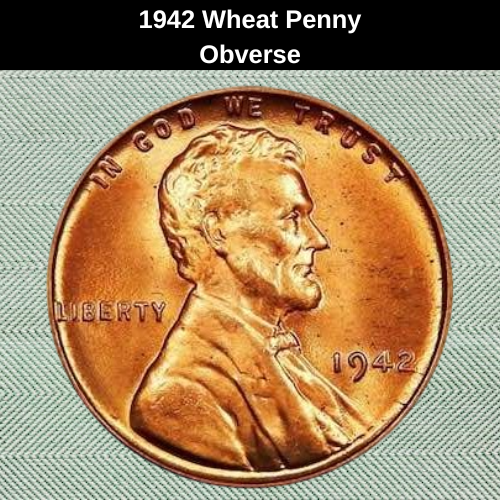
The device on the obverse of the 1942 Wheat Penny features a right-facing portrait of Abraham Lincoln, the 16th President of the United States. Just in front of Lincoln’s chest, you’ll find the mint mark and the date of the coin’s production. Behind him, along the left side, is the legend “LIBERTY”, while the national motto “IN GOD WE TRUST” arches above his head. If you look closely at the shoulder cut-off of Lincoln’s bust, you’ll notice the initials “VDB”, representing the coin’s designer, Victor David Brenner.
The Reverse of the 1942 Wheat Penny
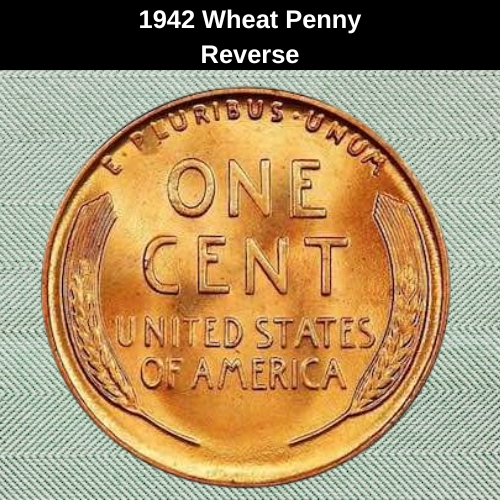
The reverse of the coin displays the motto “E Pluribus Unum” at the top in a small font. Flanking the design are two stylized wheat stalks, which give the coin its nickname—“Wheat Cent.” Beneath the motto is the denomination “ONE CENT” in bold, large lettering, followed by “UNITED STATES OF AMERICA” in a slightly smaller font. This balanced layout makes the design both iconic and easy to identify among coin collectors.
Other Features of the 1942 Wheat Penny
In 1942, the Wheat Cent was struck using a composition of 95% copper and 5% zinc. While the U.S. Mint experimented with alternative materials due to wartime metal shortages, only one such coin—a glass cent—is known to have survived. The standard 1942 penny had a diameter of 19.05 mm (0.75 inches) and weighed 3.11 grams, maintaining the traditional size and weight of pre-war Lincoln cents.
1942 Wheat Penny Grading
The value of a 1942 Wheat Penny depends heavily on its condition and color classification. Coins are graded by their wear, strike quality, and surface detail, but also by tone:
- RD (Red) – the brightest, most desirable color, often seen in uncirculated coins
- RB (Red-Brown) – a mix of red and brown hues, indicating moderate oxidation
- BN or BRN (Brown) – fully oxidized copper with the least market value
⚠️ Important: Cleaning a coin or using chemicals to enhance its color can dramatically reduce its value, even if it improves appearance.
Coin Grading Scale
| Grade # | Grade Name |
|---|---|
| 1 | Basal State-1 |
| 2 | Fair |
| 3 | Very Fair |
| 4–6 | Good |
| 7–10 | Very Good |
| 12, 15 | Fine |
| 20, 30 | Very Fine |
| 40 | Extremely Fine |
| 50 | About Uncirculated |
| 60 | Mint State (MS 60) |
| 65 | Mint State (MS 65) |
| 70 | Mint State (MS 70) |
💡 Use a reliable grading guide or consult a professional to determine your coin’s exact grade—it’s an essential step in assessing its true value.
1942 Wheat Penny Value Guides
All the experimental pieces mentioned earlier were pattern coins, produced as prototypes for testing alternative materials. Aside from the 1942 US Mint J-2069 Glass Colombian coin, which is known to have survived, most of these patterns were reportedly destroyed.
However, 1942 Wheat Pennies still exist today in two main forms:
- Proof Strikes – specially made for collectors, with extra sharp detail and mirror-like surfaces
- Business Strikes – produced for general circulation
These bronze coins (95% copper, 5% zinc) were minted at three facilities:
- Philadelphia (no mint mark, including proofs)
- Denver (mint mark “D”)
- San Francisco (mint mark “S”)
1942 No Mint Mark Wheat Penny Value
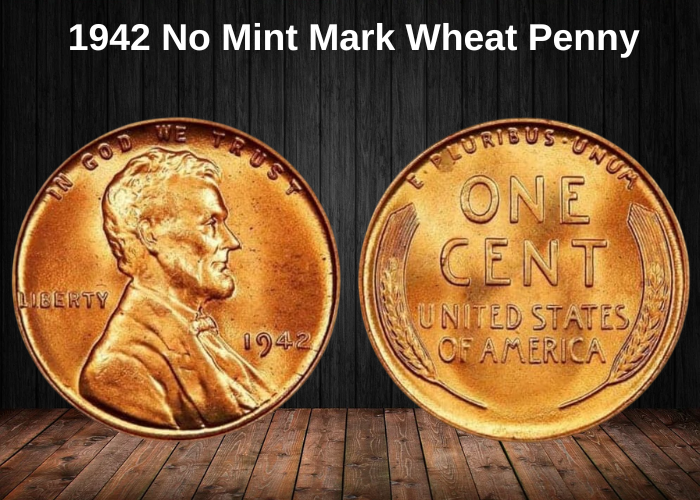
A Philadelphia Wheat Cent may be listed in different ways — such as 1942 (P), 1942 ‘P’, or simply 1942 No-Mint-Mark. Regardless of the label, these coins hold decent value. The Philadelphia Mint struck a massive 657,796,000 Wheat Pennies that year, making them fairly common, which keeps prices moderate overall.
That said, high-grade examples can fetch impressive sums. For instance:
- An AU 58 BN (Almost Uncirculated, Brown) sold for $2,990 in January 2010
- A near-perfect MS 69 RD (Mint State, Red) brought $3,960 on December 19, 2021
1942-D Wheat Penny Value
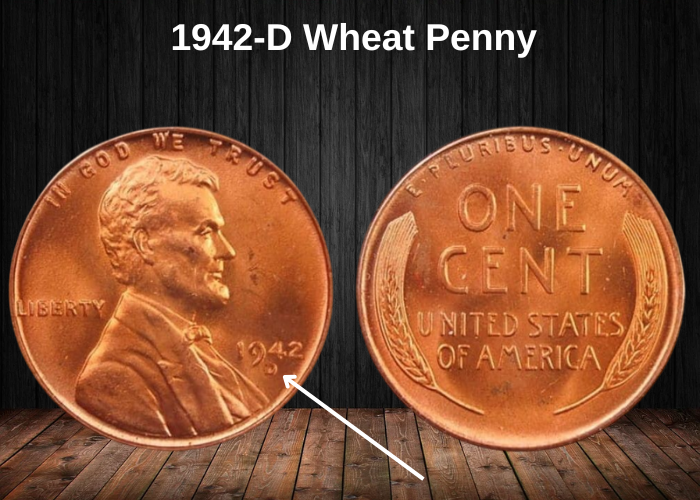
In 1942, the Denver Mint produced 206,698,000 Wheat Pennies, each bearing the “D” mint mark. That’s roughly a third of Philadelphia’s output, and their market values reflect that difference.
For example, on December 4, 2008, an MS 68 RD (Mint State, Red) sold for $12,650, climbing from $11,500 just two years earlier in January 2006. However, as of today, PCGS has graded 10 coins at this level, leading them to revise the estimated value to around $8,000.
1942-S Wheat Penny Value
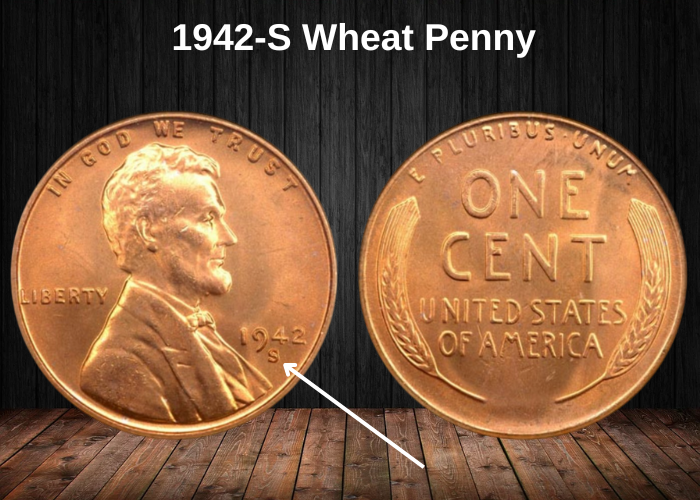
The San Francisco Mint struck 85,590,000 Wheat Pennies in 1942, each bearing the “S” mint mark. Interestingly, the price record for an MS 68 RD (Mint State, Red) is identical to its Denver counterpart—$12,650, achieved on January 1, 2006.
Submission numbers are comparable too, with PCGS having graded 7 coins at this level. As a result, the current estimated value stands at $9,500, although a sale in 2021 saw one fetch $7,800.
1942 (P) Proof Wheat Penny Value
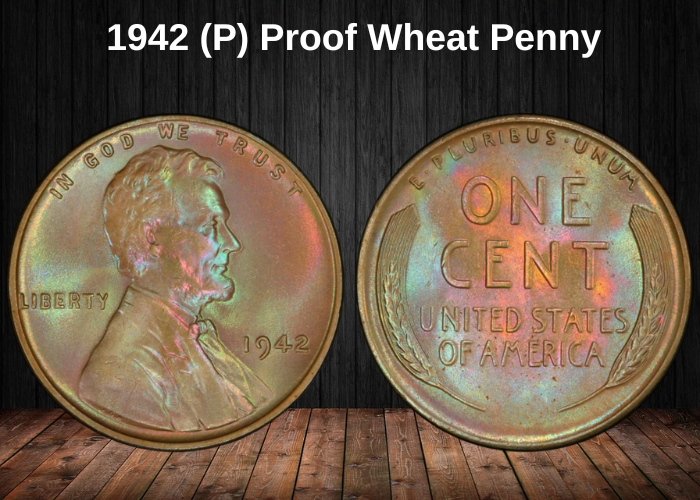
Proof coins serve two key purposes: first, they provide an official archival reference that showcases the coin’s ideal design; second, they generate additional revenue for the U.S. Mint, as collectors and investors eagerly seek them out. Proofs come in various finishes—matte, mirror-like (with frosted devices and reflective fields), or reverse proofs (with reflective devices and frosted fields). In 1942, the frosting effect was achieved through acid pickling.
To produce the mirror-like effect, both the die and planchet were meticulously polished before striking. The first 50 to 100 coins struck with a new die typically show a dramatic contrast and receive a Deep Cameo (DCAM) designation. As the die wears, the contrast diminishes—resulting in Cameo (CAM) coins, and eventually regular Red proofs.
All 1942 Wheat Penny Proofs were minted in Philadelphia, so they carry no mint mark. Only 32,600 proof coins were produced that year, making them relatively scarce.
Some of the highest auction prices include:
- PR 66 BN – $1,265 (sold on July 7, 2003)
- PR 67 RB – $1,528 (sold on February 16, 2017)
- PR 67+ RD – $4,080 (sold on September 20, 2020)
- PR 67 CAM – $17,625 (sold on February 3, 2014) – current estimate: $18,000
Rare 1942 Wheat Penny Error List
1942 (P) Wheat Penny DDO Errors FS-101 to FS-104
DDO, or Doubled Die Error, occurs when the die is struck more than once, with the second strike landing slightly off-center, resulting in doubled images that transfer onto the coins produced. This is often referred to as hub doubling because it happens when the hub (the die used to create the design) strikes the coin die.
In the case of the 1942 (P) Wheat Penny, there were four DDO varieties identified, ranging from FS-101 to FS-104. These varieties differ in the degree of doubling and where it appears on the coin.
Regarding prices, an MS 65 RD example was valued at $475 in 2023, while a MS 65 RB coin was sold on eBay for $1,200 in 2022. These values vary based on the condition and the specific variety of the DDO error.
1942-D/D Wheat Penny RPM Errors FS-502 to FS-504
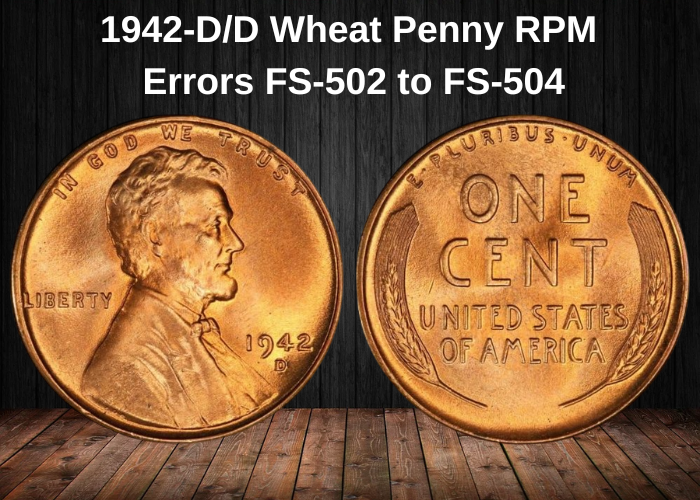
DDO, or Doubled Die Error, occurs when the die is struck more than once, with the second strike landing slightly off-center, resulting in doubled images that transfer onto the coins produced. This is often referred to as hub doubling because it happens when the hub (the die used to create the design) strikes the coin die.
In the case of the 1942 (P) Wheat Penny, there were four DDO varieties identified, ranging from FS-101 to FS-104. These varieties differ in the degree of doubling and where it appears on the coin.
Regarding prices, an MS 65 RD example was valued at $475 in 2023, while a MS 65 RB coin was sold on eBay for $1,200 in 2022. These values vary based on the condition and the specific variety of the DDO error.
1942-S/S Wheat Penny RPM Error FS-512
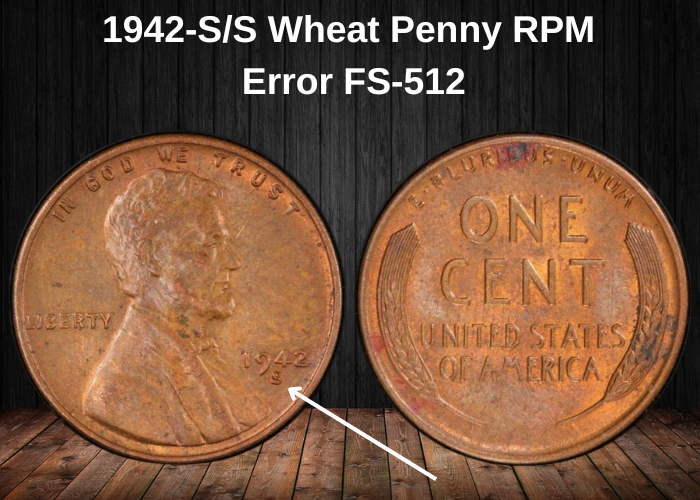
The 1942 San Francisco Wheat Cent had a few mint mark errors that are highly collectible. This was during a time when the San Francisco Mint was still producing regular strikes (also known as business strikes), before it became focused primarily on proof coin production.
One notable minting error involved the S/S mint mark, which occurs when the mint mark is incorrectly punched over a previous mint mark.
For example, a MS 67 RD 1942 S/S penny sold for $1,763 on January 30th, 2020, while another coin of the same grade was sold for $1,350 in a 2018 eBay auction. These mint mark errors are sought after due to their rarity and the unique aspect of the minting mistake.
1942-S/S/S Wheat Penny RPM Plus DDO Errors FS 101/301
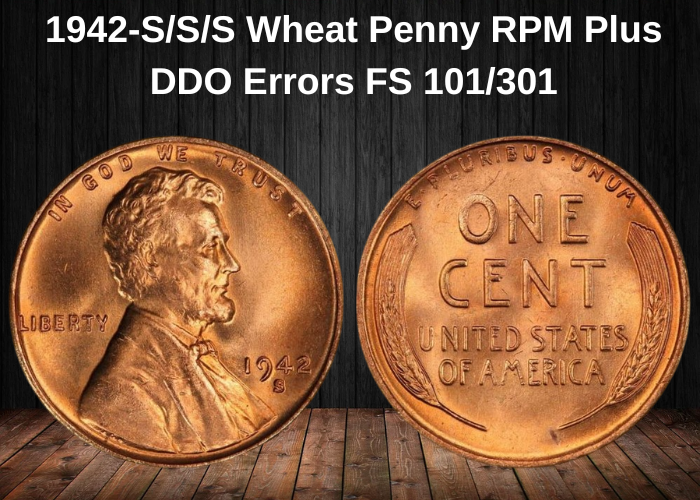
When a coin features multiple mint mistakes, its value increases significantly due to the rarity and uniqueness of such errors. In the case of the 1942-S Wheat Penny, the coin had both hub doubling and a triple-punched mint mark, which are considered significant minting errors.
Even though authoritative appraisers might not rank it at the highest level, the coin’s value is driven by supply and demand. In this case, a 1942-S Wheat Cent with these errors, graded MS 67 RD, sold for $2,350 on July 17th, 2019, on eBay. This price reflects the strong collector interest in coins with such distinctive and rare characteristics.
1942-S Wheat Penny DDO Error
The 1942-S Wheat Penny DDO (Doubled Die Error) is not as valuable as its Philadelphia counterpart with the same error, but it still holds some worth among collectors. While DDO errors from Philadelphia can sometimes fetch $1,000 or more, the 1942-S example tends to be less expensive. For instance, a 1942-S DDO in MS 64 RD condition sold for $440 back in 2012.
Even though its value is not as high as some other DDOs, it’s still a good addition to a collection. Adding this coin can help you create a comprehensive set of Wheat Pennies with various mint errors, which could be a valuable asset in the future, especially for those who appreciate collecting rare minting mistakes.
1942 (P) Wheat Penny Thick Planchet Error
Coins struck on the wrong planchet (also known as a wrong planchet error) can be highly valuable, as they represent minting mistakes where a coin is struck on a blank intended for another denomination. For instance, a 1942 Philadelphia Penny that was mistakenly struck on a 4.11g blank instead of the usual 3.11g can stand out due to its heavier weight.
Such errors are rare, and collectors often find them intriguing and valuable. In this case, the MS 62 BN 1942 penny with the wrong planchet error sold for $1,645, showing how significant the error can be in determining the coin’s value.
If you’re a coin collector, it’s a good idea to weigh your coins to ensure they match their expected weight, as a difference could indicate a potential minting mistake that could increase the coin’s value.
1942 (P) Wheat Penny Struck on a Dime Planchet
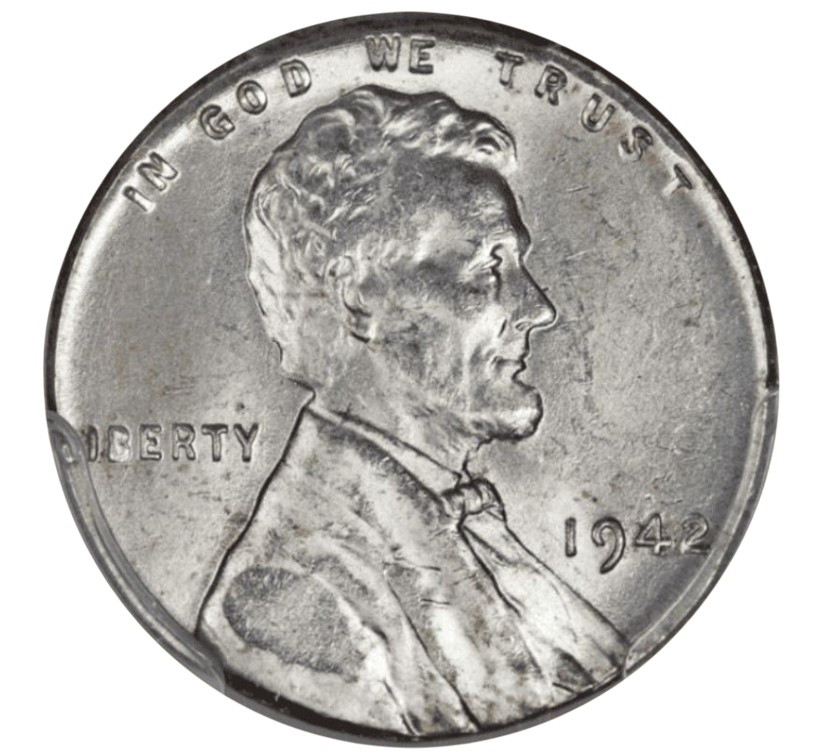
The wrong denomination planchet error is an even rarer and more valuable mistake in coin minting. In this case, a 1942 penny design was mistakenly struck on a silver 10-cent (dime) blank. Since pennies are 19mm in diameter and dimes are 17.9mm, this error caused the coin’s size, color, and weight to be incorrect.
Additionally, because the penny design was too large for the dime blank, some of the inscriptions on the coin were sliced off. Despite these issues, this type of error is highly sought after by collectors. An AU 58 example of this error sold for over $14,000 due to its rarity and unique characteristics.
For collectors, these kinds of minting mistakes are highly collectible and can greatly increase the value of a coin.
1942 (P) Wheat Penny Mirror Brockage Struck 40% Off-Centre
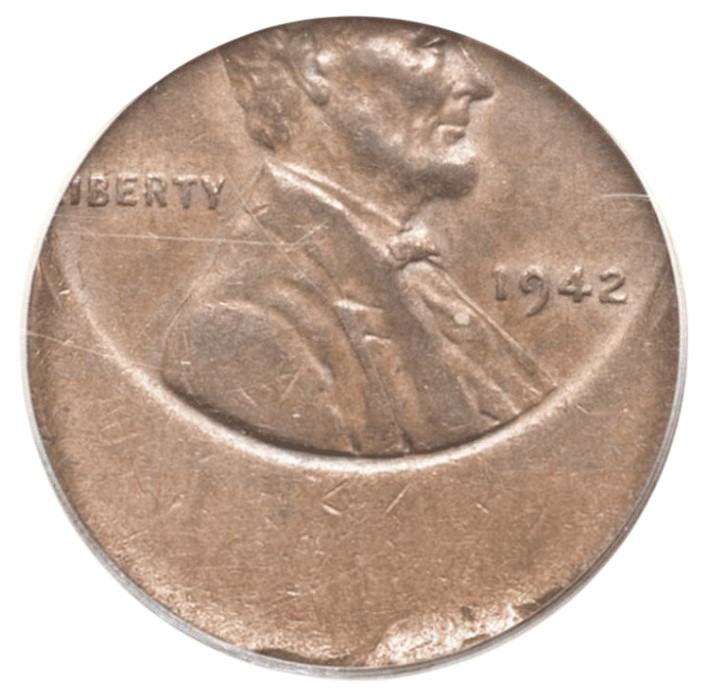
A brockage error occurs when a previously struck coin becomes stuck to the die, essentially acting as a “die cap.” This results in the design from the previously struck coin being transferred onto the new planchet. However, if the coin is already on its way out of the press when this happens, the new coin may be misaligned, leaving parts of the coin blank on both sides.
In the case of the 1942 Wheat Penny, this resulted in a mirror brockage error where the coin was not only damaged but also 40% misaligned, creating a unique dual error. The coin had portions of its design missing due to the misalignment and brockage, which made it particularly valuable to collectors.
An example of this coin, graded MS 62 BN, was sold for $2,500. The combination of the brockage and misalignment errors, along with its rarity, increased its value significantly.
1942 (P) Wheat Penny Struck Thru a Fragment
Minor errors, like fragments or small minting mistakes, can indeed be valuable to collectors. For example, a 1942 Wheat Penny with such an error, graded AU 55 BN, sold for $485. However, finding these errors in circulation is quite rare, as they’re often picked out by collectors before they even make it into regular change.
If you’re new to collecting coins and looking for valuable Wheat Penny errors, a good strategy would be to buy coin rolls and examine them carefully. Using a coin microscope can help you spot finer details like the 1942-D RPMs (re-punched mint marks) or 1942 (P) FS-101 to FS-104 DDOs (doubled die obverses). These specific errors are well-known in the coin community and can be valuable depending on their condition and rarity.
Where to sell your penny?
Now that you know the value of your penny, you might be wondering where to sell it. Don’t worry: here’s a guide to some of the best online platforms where you can easily sell your coins, along with their advantages and disadvantages.
Discover the best platforms for selling coins online (pros and cons).
1942 Wheat Penny FAQ
1. Why is the 1942 Wheat Penny considered a transitional coin in U.S. numismatic history?
The 1942 Wheat Penny is significant because it was minted during a transitional period just as the United States entered World War II. While the 1942 penny retained the traditional 95% copper, 5% tin and zinc composition, it was one of the last copper cents before the wartime steel penny of 1943. The coin serves as a bridge between pre-war coinage and the resource-conserving changes that followed, making it a key piece in understanding how global conflict directly influenced U.S. currency.
2. How did the wartime economy begin to impact coin production decisions by the time the 1942 penny was minted?
By 1942, the United States had officially entered WWII, and copper—a primary component of pennies—was being rationed for ammunition, communications wiring, and military vehicles. Although the 1942 penny was still made of copper, the Mint began experimenting with alternative materials this same year, preparing for the transition to steel cents in 1943. These behind-the-scenes decisions in 1942 show how coin production was already adapting to the wartime economy.
3. Are there any notable varieties or mint errors in the 1942 Wheat Penny series that collectors seek out?
Yes, collectors often seek out the following varieties and mint errors in the 1942 series:
- 1942-D/D RPM (Repunched Mintmark) – A variety where the “D” mint mark from Denver was stamped twice.
- 1942-D over Horizontal D – A repunched “D” mint mark with a horizontal shadow, which adds numismatic value.
- Die cracks, cuds, or lamination errors – Although not exclusive to 1942, these minting flaws can increase value. These errors are especially valuable in high grades and for collectors who specialize in error coins.
4. How do the values of 1942 Wheat Pennies differ by mint mark and condition?
The 1942 Wheat Penny was minted in Philadelphia (no mint mark), Denver (D), and San Francisco (S):
- Philadelphia: ~657 million minted. Most common.
- Denver: ~206 million.
- San Francisco: ~85 million. Least common and most valuable in higher grades.
In circulated condition, all varieties are common and worth a few cents to $1. However, uncirculated examples (especially MS-65 and above) can be worth $10–$50+, and varieties like RPMs or errors can fetch significantly more depending on rarity and condition.
5. What are the differences between 1942 Wheat Pennies and the 1943 Steel Cents, and why is this comparison important?
The 1942 Wheat Penny is made of copper, whereas the 1943 penny was made of zinc-coated steel due to wartime copper shortages. This comparison is important because it highlights how external geopolitical forces—like WWII—can drastically influence the materials used in coinage. Additionally, many people mistakenly believe all copper pennies from the 1940s are common, which is not true—a 1943 copper penny is an ultra-rare error, making knowledge of the 1942-43 transition vital for collectors.
6. In what way does the 1942 Wheat Penny reflect the values and symbolism of the time through its design?
The design of the 1942 Wheat Penny continues to use Victor David Brenner’s classic 1909 design, which features Abraham Lincoln on the obverse and two wheat stalks on the reverse. During the early 1940s, these elements symbolized honesty, national unity, and agricultural strength—values that aligned closely with wartime propaganda. Lincoln represented enduring American leadership and morality, while the wheat represented the sustenance and labor of the American people contributing to the war effort.
7. How does the 1942 Wheat Penny help modern collectors better understand the evolution of American coinage under pressure?
The 1942 penny offers an excellent case study in how external factors like war, resource allocation, and economic shifts influence coin production. It shows how the U.S. Mint adapted to new realities—by 1943, these adaptations would manifest physically in the steel cent. For collectors and historians, studying the 1942 penny helps trace the narrative of America’s resilience and flexibility, as seen through the lens of everyday objects like a simple one-cent coin.




















































Tengo un coins del año 1942 S donde podré venderlo está muy bueno no esta gastada ni rayoniada
Use our tool to determine its market value.